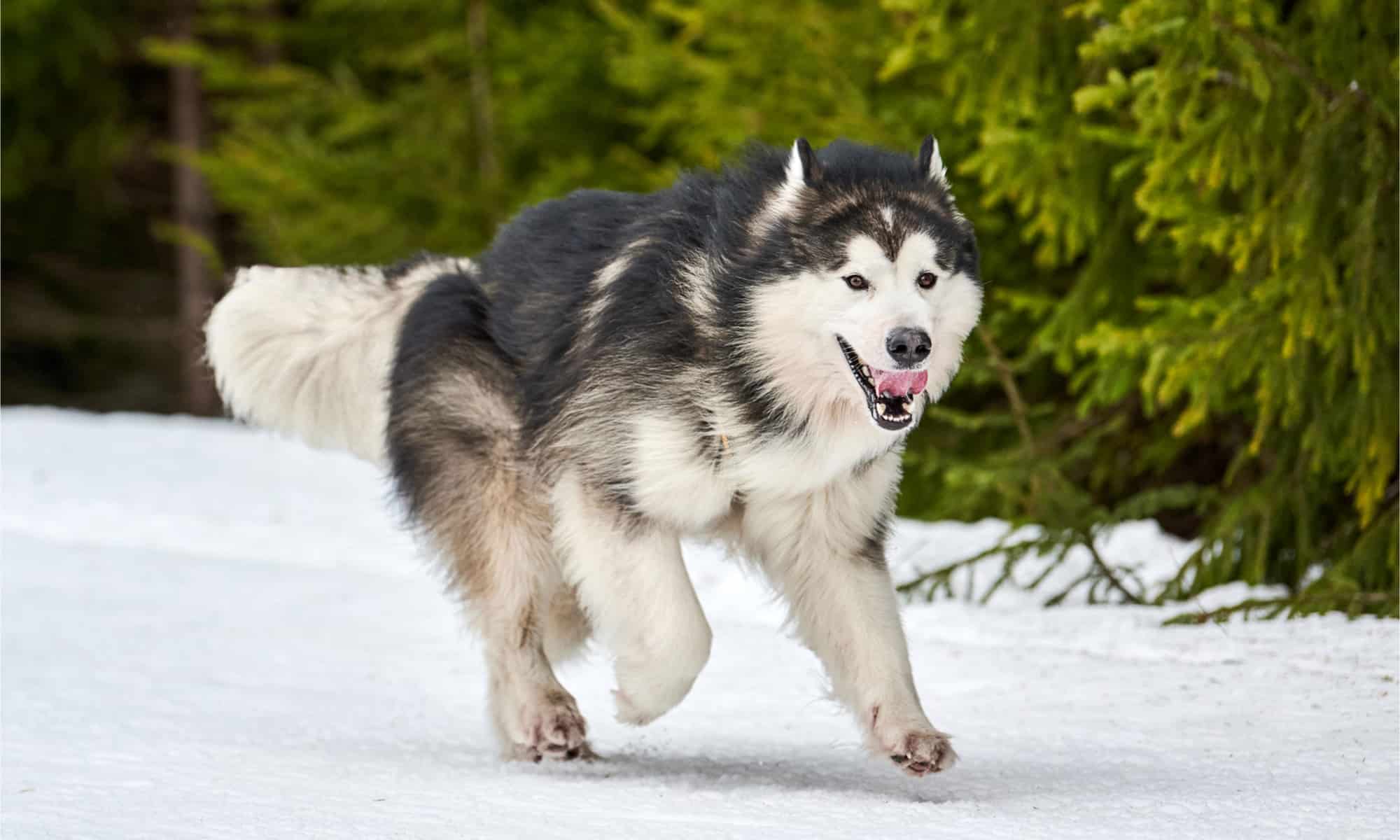Alaska is considered the last frontier of North America because of its breathtaking natural beauty, top-notch fish, and massive glaciers. In this part of the Arctic, few people live in the often harsh environment of Alaska. However, this state is home to a wide variety of animals, including dogs.
Sled dogs, a particular type or group of dog breeds, rule the cold environment of Alaska. Most of the native breeds of dogs in Alaska are utilized for this kind of job, though not all of them are. Even now, many people travel over the Arctic tundra by dog sled. And a robust dog is needed in such a hard region of the earth.
Alaskan dogs are not your normal breeds. To keep them warm throughout the chilly winter months, they must be bred to have a thick fur coat. Just as well, the majority of Alaskan dogs were developed to pull sleds, thus they require a lot of stamina and physical strength. The temperature and geography are perfectly suited to Alaskan dog breeds that have these features. They often have a tough, active, and energetic nature. They also can become devoted, loving companions to their human friends.
Ready to learn about some seriously awesome Alaska dog breeds? Let’s take a look at some of the best breeds that were created in Alaska

1. Alaskan Malamute

The Alaskan Malamute (pictured) is a very strong dog.
©Aneta Jungerova/Shutterstock.com
The biggest of the Alaskan dog breeds is the Alaskan malamute. The malamute is a powerful dog, towering over two feet tall and weighing up to 80 pounds. They are among the best canines at hauling hefty sleds because of their size.
In Alaska, the malamute was bred for a variety of purposes and occupations. In the past, they were employed for hunting seals and polar bears. Currently, their main purpose is to haul large crates of products and goods. The malamute is required to be swift, powerful, and have tremendous stamina for these tasks.
Historically, Alaskan malamutes historically played a significant role in World War II. They were primarily employed as search and rescue dogs, weapon bearers, and mine detector dogs.
The malamute is a true mainstay of sled dog breeds. They aren’t as adept at speed or long-distance travel as huskies, though. Instead, they move more slowly and cover considerably less ground. But, because of their size, they can move up to a staggering 3,000 pounds of weight when working in groups.
The malamute typically pulls camp equipment, food boxes, and other larger loads in addition to people. They will thus have plenty of energy and typically require at least two hours of vigorous physical exercise each day. The majority of the well-known Arctic dog breeds and other spitz-type dog breeds share characteristics with Alaskan malamutes. Malamutes and huskies are actually quite similar, and the former is sometimes referred to as just being bigger and heavier husky.
2. Alaskan Husky
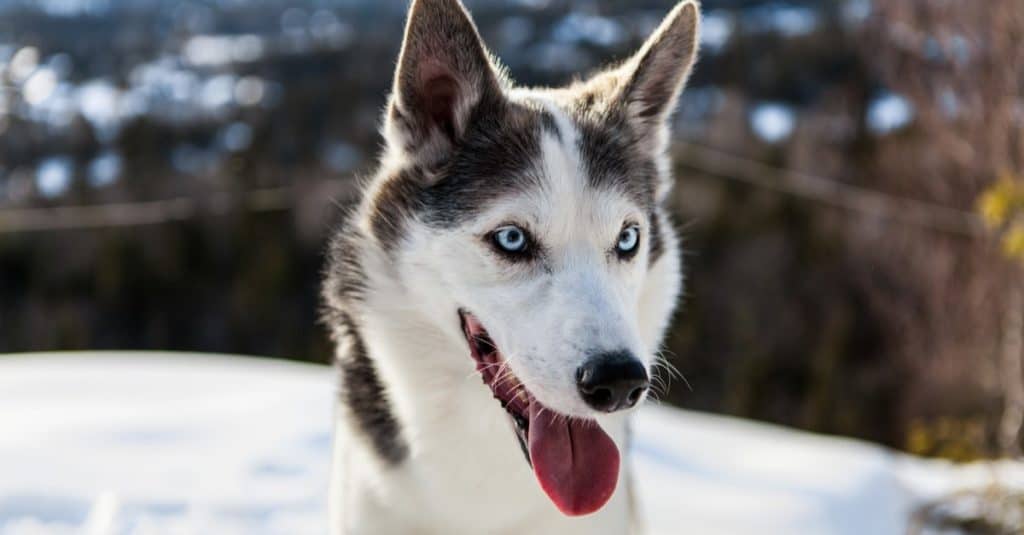
The
Alaskan husky
(pictured) has a lot of stamina.
©Valmedia/Shutterstock.com
When many people think of huskies, they tend to think of the well-known Siberian husky. What distinguishes an Alaskan husky from a Siberian husky, then? While having extremely similar genetic roots, the two breeds do differ in a few ways. For instance, an Alaskan husky has a more pronounced tuck-up and is leaner. The captivating blue eyes of the Siberian husky are well recognized. The Alaskan husky, however, will primarily have brown eyes.
Although they weigh about the same, Alaskans tend to be somewhat smaller in stature. The temperament of the two, though, is what genuinely distinguishes them. Alaskan huskies were raised with the sole purpose of hauling sleds. Because of their greater endurance, Alaskans are usually the breed of dog utilized in long-distance competitions. In a single day, they can run 100 miles!
The Alaskan husky, in contrast to the Siberian husky, is an unregistered breed. Even now, some still classify them as hybrid dogs. Siberians are working dogs, but they also participate in dog shows as show dogs, which may help to explain why one breed is acknowledged but not the other.
The Siberian husky, Italian greyhound, and German short-haired pointer were all combined to create the hybrid dog known as the Alaskan husky. Contrary to popular assumption, the husky is a much more recent breed of dog in North America. In reality, its Siberian husky ancestor is thought to have arrived on the continent for the first time in 1908. Before Siberian huskies were properly bred in Alaska, it required several decades of experimentation. When they did, some breeders began breeding for speed and endurance, which is how the somewhat modified Alaskan husky we see today came to be.
3. Malanees Dog
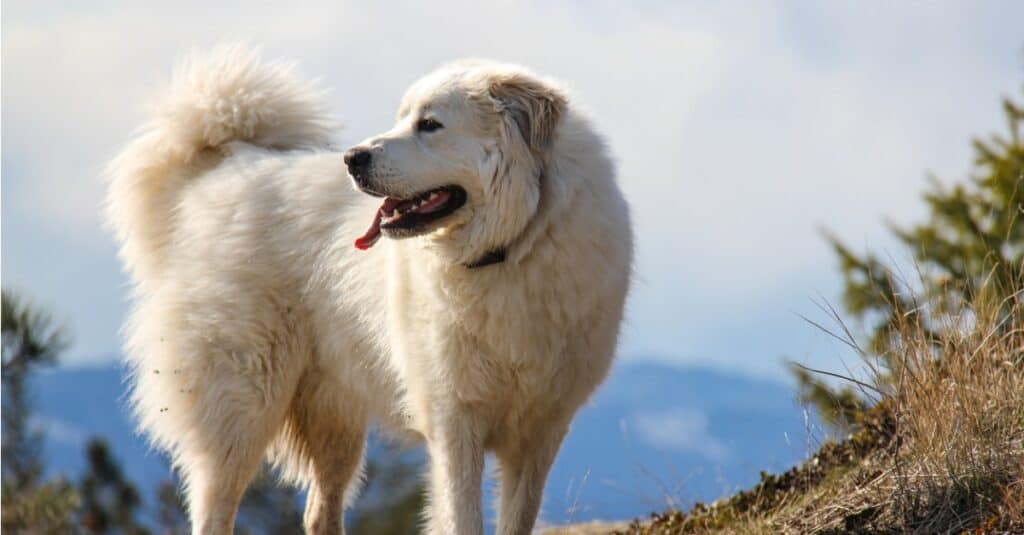
The Malanees is a combination of the Alaskan malamute and the
Great Pyrenees
(pictured) dog breeds.
©iStock.com/creativex
Our next entry in this list of Alaskan dog breeds is a hybrid. This huge, fluffy hybrid breed combines the powerful Great Pyrenees and the tenacious Alaskan malamute. While the Malanees’ coat has less bulk than its Malamute parent, it is nevertheless well suited to the chilly alpine climate. In hotter regions, they don’t fare as well, thus daily river journeys are suggested throughout the summer.
A Malanees’ coat will often be the same bright white as that of a Great Pyrenees. Especially around the eyes and on the nose, they frequently acquire some of the darker markings of an Alaskan malamute. Depending on how the parent Malamute’s coat looks, you may see varying hues of brown, silver, and red on their coat.
The Malanees is a working-class dog with high strength and a strong sense of drive that is built to pull and serve as guards. Malanees appreciate spending time with their family, although occasionally being a touch obstinate, and they are extremely kind and affectionate with youngsters.
These dogs are adorable, but they are also stubborn. One of the reasons why many people don’t advise the breed to novice dog owners is because of their stubborn nature. If you can handle it, these dogs really do make great pets. The Malanees are fairly energetic dogs who can walk for what seems like miles at a time.
4. Alaskan Klee Kai Dog
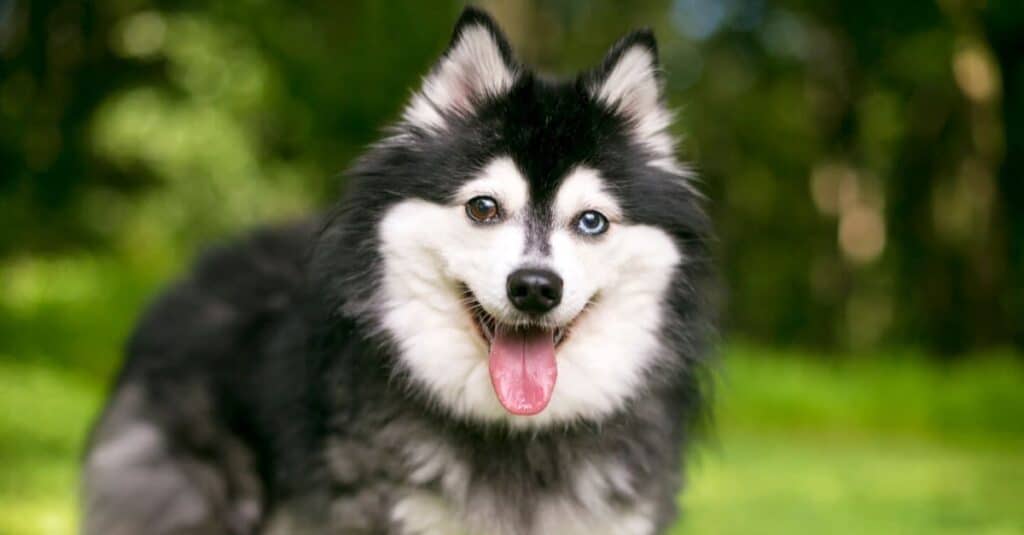
Alaskan Kee Kai dogs (pictured) are often referred to as miniature huskies.
©Mary Swift/Shutterstock.com
The Klee Kai dog is not the usual breed of canine seen in Alaska. The Alaskan Klee Kai was created for friendship, as opposed to the other breeds, which were developed for varied tasks in the icy environment. These little canines will only have a maximum weight of 20 pounds. In essence, Klee Kais look similar to Alaskan huskies on a smaller scale. While they share variances in temperament, the two different dog breeds appear to be extremely similar in appearance.
The Alaskan Klee Kai dogs, however, are not little huskies. These dogs were created to be friends, not working machines. The Klee Kai’s basic sizes set them apart from huskies even further. The three sizes of these dogs are toy, miniature, and standard. Therefore, some Alaskan Klee Kais can reach heights of 13 inches, while others will be slightly taller. Even the name “Klee Kai” translates to “small dog.”
Although they are a relatively new dog breed, these dogs have very quickly gained popularity. And in 1997, the United Kennel Club officially acknowledged the Klee Kai as a legitimate dog breed, establishing their status as a top Alaskan companion in the canine world.
Because they typically only have one to three puppies at a time in their exceedingly tiny litters, Alaskan Klee Kais are rather uncommon, especially outside of Alaska. The husky ancestry of the Klee Kai is said to be responsible for their bright and vivacious demeanor.
5. Alaskan Malador
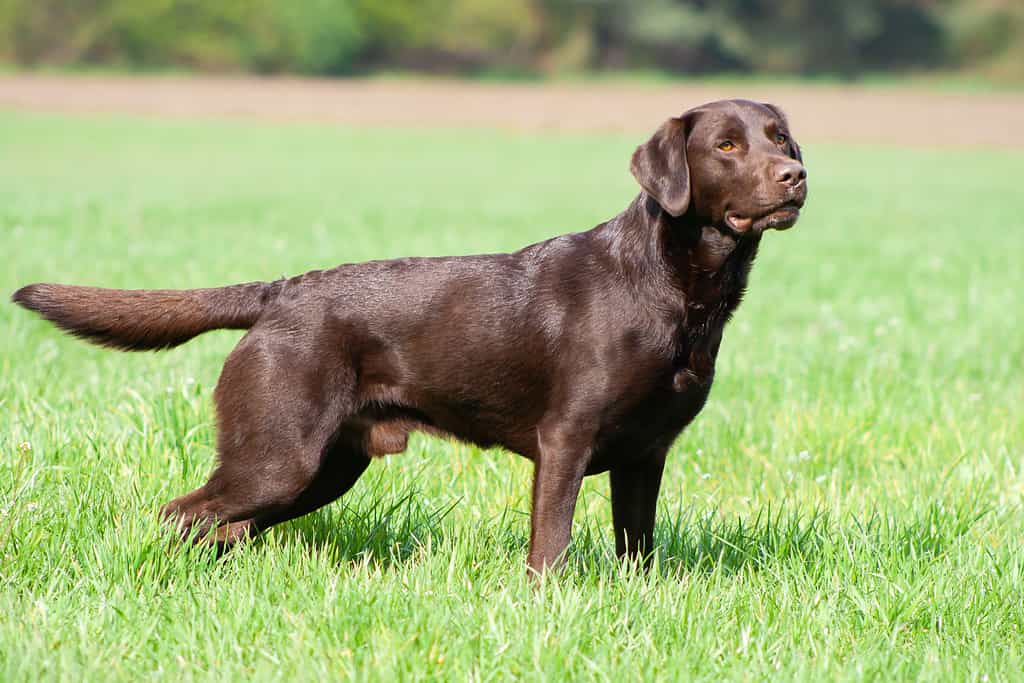
The Alaskan Malador is a cross between a
labrador retriever
(pictured) and an Alaskan Malamute.
©REN Photography/Shutterstock.com
The next of the Alaskan dog breeds is a jovial relative of the Arctic breeds. The Alaskan Malador is a cross between the Alaskan malamute and the labrador retriever. Although it has been around since way back in the 1800s, this crossbreed is a very uncommon breed that is not recognized by kennel clubs.
While they have thick, waterproof coats, they are not as well-suited to extreme cold as purebred arctic dogs. There is a lot of variance in the look of the Alaskan Malador since they are crossbred dogs. Depending on their pedigree, Malador puppies can closely resemble either of their parent breeds or they might appear to be a purebred malamute or purebred labrador hybrid. They can weigh up to 85 pounds and stand two feet tall.
Although Alaskan Maladors’ eyes are typically almond-shaped and brown, some of them occasionally exhibit hazel, yellow, or even blue eyes. The black face markings of an Alaskan malamute are typically present in Maladors, and some of these markings may also appear on the chest and legs.
They are a well-liked option for owners who desire an Alaskan malamute but don’t want to give up their current pets because of their issues with living in multi-pet families. Maladors are well-recognized for being loving and affectionate pets, so those seeking a new best friend won’t be let down by this breed! Alaskan Maladors are friendly, energetic, and incredibly devoted to their families.
6. Alusky
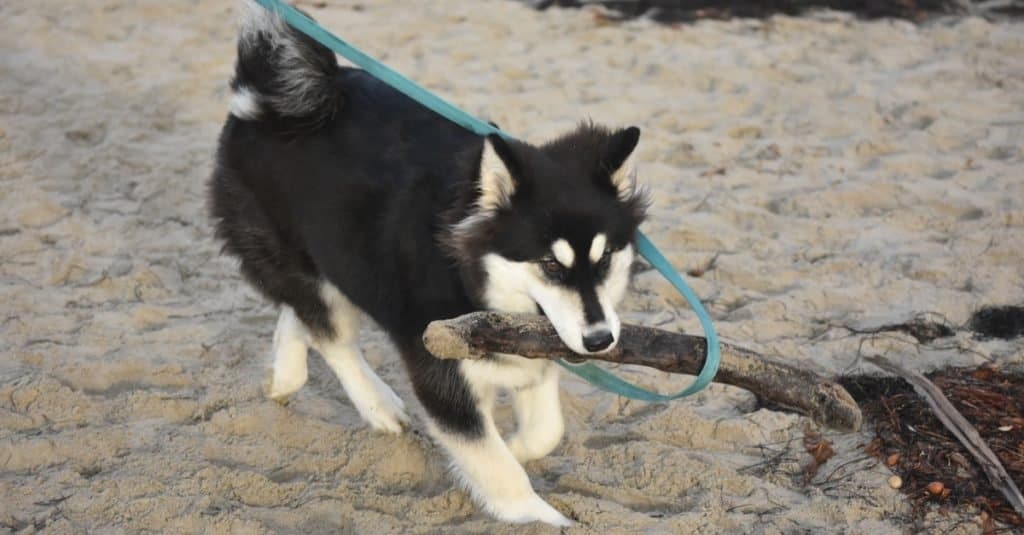
The Alusky dog (pictured) makes for an excellent companion dog.
©DejaVuDesigns/Shutterstock.com
The Alusky is not considered a purebred dog, but there’s still a lot to love about them. They are actually a cross between the husky and the Alaskan malamute, the two most well-known canines from Alaska.
You might anticipate the Alusky to have the same instincts and drive to pull sleds since both of its parent breeds were originally developed to be sled dogs. Also, it’s possible that both individuals’ high levels of energy and outgoing personalities will be inherited by an Alusky pup.
These canines’ sizes can vary, usually falling between medium and large. They will nevertheless always be well-built, strong, and resilient. Depending on whose parent the dog’s almond-shaped eyes derive the most from, they may be brown, blue, or a combination of both. Moreover, the Alusky’s double coat of fur can be any number of colors. The color options include white, gray, brown, cream, or gold. One can expect the Alusky to have wolf-like traits because both parents have uncanny similarities to wild wolves.
Little is known about these dogs because they are extremely uncommon and are still referred to as hybrid dogs. They were developed in Alaska to provide a more flexible choice for hauling sleighs, but the breeding practices behind them are a bit mysterious.
Malamutes can draw bigger weights but huskies are faster at hauling sleds. The Alusky, therefore, achieves a good balance between the two when combined. They can travel more quickly than the malamute, but they can carry a heavier weight than the husky. These dogs haven’t been widely adopted in Alaska despite this modest advantage, but we can expect them to become more popular in the coming years.
7. Malamoodle
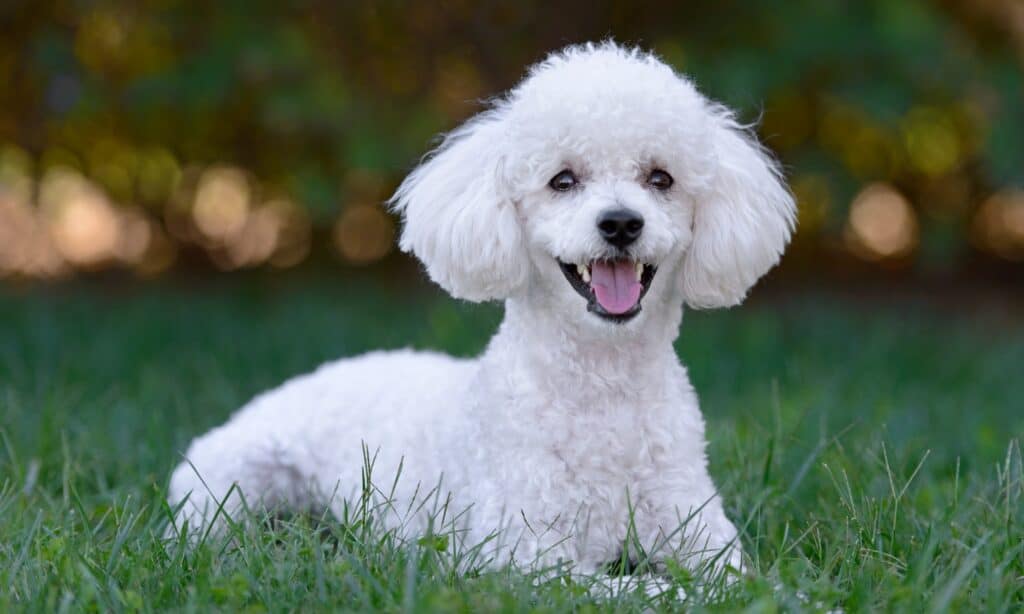
The Malamoodle is a combination of the poodle (pictured) and the Alaskan malamute.
©iStock.com/tsik
The name is a bit odd, but this dog deserves a spot on our list due to its ancestry. This crossbreed is a mix between the Alaskan malamute and the common poodle. Breeders likely initially started crossbreeding several Alaskan breeds in the 1980s in an effort to create dogs that were smaller, hypoallergenic, or simply milder hybrids of some of the more well-known Alaskan dog breeds.
The Malamoodle is not allowed to join the American Kennel Club since it is not a purebred dog. However, both of its parent breeds are included. This huge dog would be a wonderful family pet. They can weigh up to 120 pounds and have a height of 28 inches. It should come as no surprise that the Malamoodle has a thick, coarse double coat that will need to be brushed several times a week to maintain minimal shedding and its best appearance.
For this breed to be obedient and sociable, early socialization is necessary. They are renowned for being wonderful with children, strangers, and other animals. They are household dogs, therefore leaving them unattended might lead to problems. The Malamoodle will be challenging to train as well. The Alaskan malamute part of this big ol’ dog can make them a stubborn dog who will require patience coupled with a firm, persistent approach to establish pack leadership. The very smart poodle side of this dog makes them quick to learn commands.
8. Alaskan Chinook
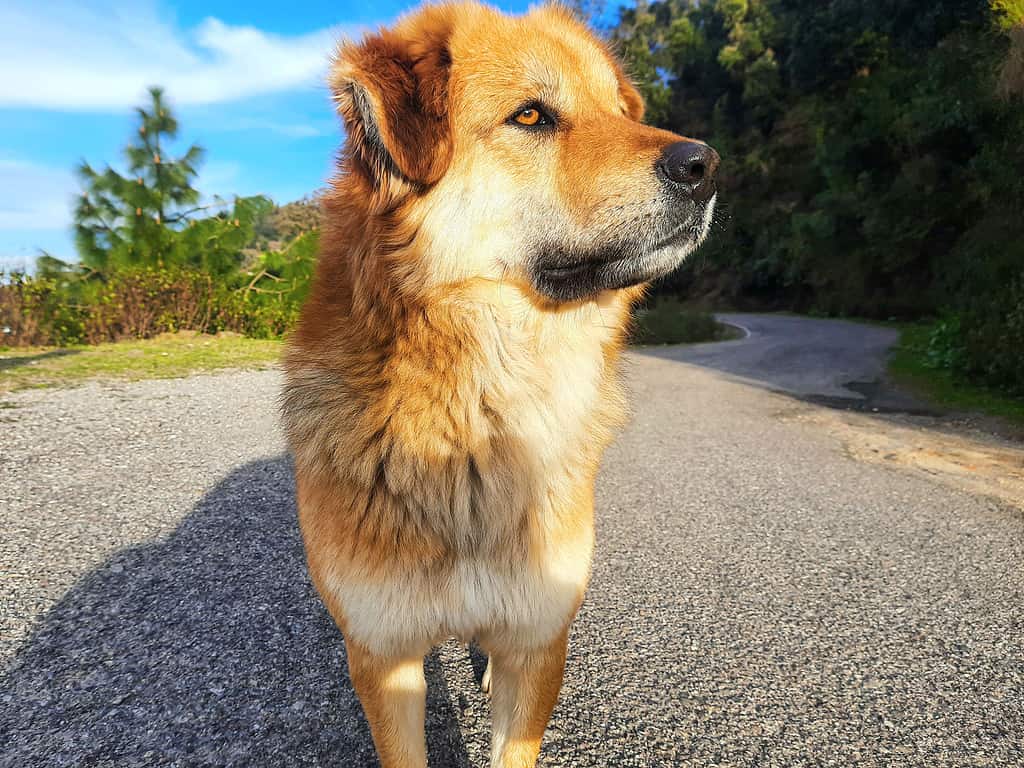
The Alaskan Chinook dog (pictured) is a fantastic working dog.
©rwtrahul/Shutterstock.com
This cross between the New Hampshire-bred Chinook and the Alaskan malamute is worthy of a mention on this list of Alaskan dog breeds. This genuine workhorse of a dog was created when the Chinook’s relentless pace and the malamute’s cold-weather resistance combined.
This breed’s coat serves a certain function and is ideal for Alaskan dogs. This breed of sled dog has two coats. Each of these coats differs in length and texture, which contributes to the breed’s overall toughness and resiliency in cold weather. The Alaskan Chinook’s undercoat is thick and made up of fine, medium-length hair. In cases of harsh weather, such as chilly winter winds or other living circumstances, this layer offers the insulation and heating needed. They often have a honey or tan overall tint to their coat and look somewhat like Alaskan huskies.
This unusual breed, which was formerly developed to be among the best in terms of agility and endurance, has passed its prime. The history of the Alaskan Chinook dog breed has been turbulent, with multiple instances where it was even brought to the verge of extinction. They are now regarded as one of man’s finest and truest friends and their days as Alaskan explorers are long gone. Even during the most demanding exercises, they won’t abandon you. Thus, this is a fantastic dog for hikers. The Alaskan Chinook is kind, lively, and especially loyal to young children.
Summary of 8 Best Types of Alaskan Dog Breeds
| Rank | Dog Breed | Lineage |
|---|---|---|
| 1 | Alaskan Malamute | Purebred; Hinman, Kotzebue, and M’Loot malamutes |
| 2 | Alaskan Husky | Mixed; may be parts of Alaskan & Siberian husky, German shorthair pointer, and Eskimo dog |
| 3 | Malanees Dog | Mixed; Alaskan malamute and Great Pyrenees |
| 4 | Alaskan Klee Kai Dog | Purebred; Alaskan and Siberian husky |
| 5 | Alaskan Malador | Mixed; Alaskan Malamute and the Labrador Retriever |
| 6 | Alusky | Mixed; Alaskan husky and malamute |
| 7 | Malamoodle | Mixed; poodle and malamute |
| 8 | Alaskan Chinook | Purebred – husky & shepherd |
Ready to discover the top 10 cutest dog breeds in the entire world?
How about the fastest dogs, the largest dogs and those that are -- quite frankly -- just the kindest dogs on the planet? Each day, AZ Animals sends out lists just like this to our thousands of email subscribers. And the best part? It's FREE. Join today by entering your email below.
Thank you for reading! Have some feedback for us? Contact the AZ Animals editorial team.

